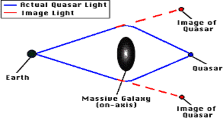84. GRAVITATIONAL LENSING


Imagine a bright object such as a star, a galaxy, or a quasar, that is very far away from Earth (say...10 billion light years). For our discussion, let us imagine we have a quasar. If there is nothing between it and us, we see one image of the quasar. Yet, if a massive galaxy (or cluster of galaxies) is blocking the direct view to the quasar, the light will be bent by the gravitational field around the galaxy [see figure below]. This is called "gravitational lensing," since the gravity of the intervening galaxy acts like a lens to redirect the light rays. But rather than creating a single image of the quasar, the gravitational lens creates multiple images. We follow the
light rays from the Earth to the apparent locations of the quasar. If the galaxy were perfectly symmetric with respect to the line between the quasar and the Earth, then we would see a ring of quasars!
